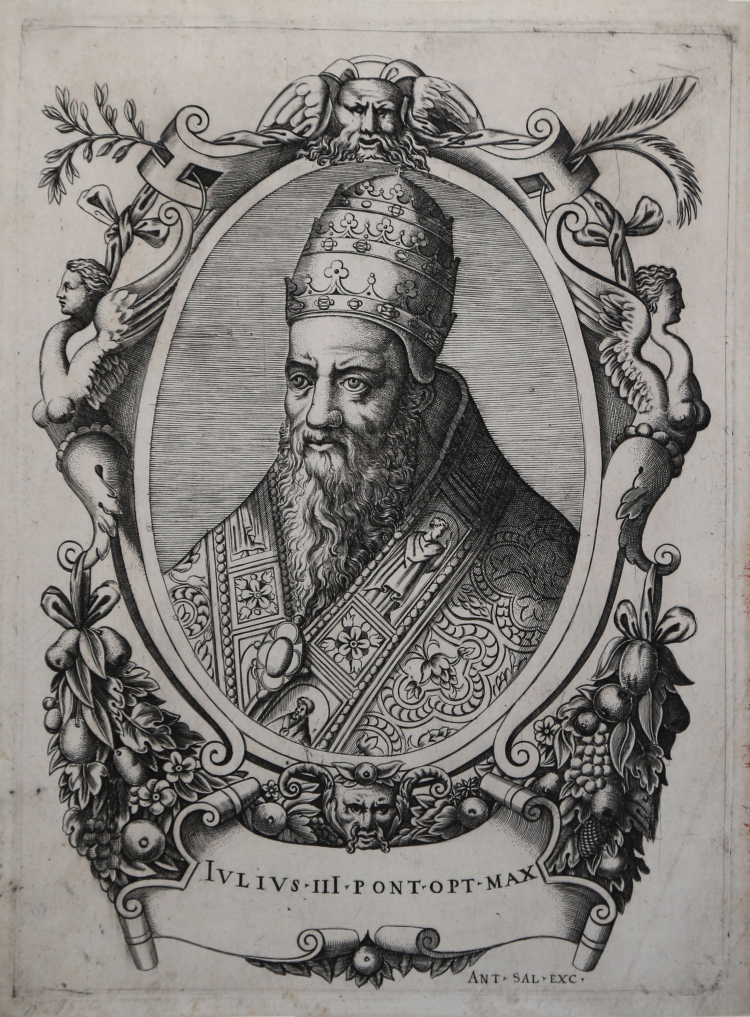




| Reference: | S30496 |
| Author | Nicolas Beatrizet detto BEATRICETTO |
| Year: | 1550 ca. |
| Measures: | 217 x 300 mm |



| Reference: | S30496 |
| Author | Nicolas Beatrizet detto BEATRICETTO |
| Year: | 1550 ca. |
| Measures: | 217 x 300 mm |
Engraving, ca. 1550/55, signed in plate at lower right excudit of Antonio Salamanca: ANT. SAL. EXC.
Magnificent proof, printed on contemporary laid paper, in excellent condition.
Portrait of Pope Julius III (1550-1555), with papal tiara, contained within elaborate oval frame. The work is not described by Bartsch and is attributable on stylistic grounds to the hand of Beatricetto.
Work assigned by Bassenge sale cat. 73, 1999, 14, 5223; Idem 75, 2000, 11, 5016. The prototype from which this engraving was derived is not known. Passavant (1864, VI, 101, 87) and Nagler (I, 689, 1563/1) assign the work to the Master of the Die, making a generic reference to the presence of an initials of which we have found no evidence. For stylistic and chronological reasons (the pontificate of Julius III took place between 1550 and 1555) an attribution to Beatrizet seems more likely. A copy of the frame of this portrait was used for a Portrait of Gregory XIII, mm. 290x215, Rome 1572, published by Palombi (cf. Bianchi, IV, p. 6).
Collection mark of Thomas Jefferson Coolidge, Jr. (Lugt 1429), on verso.
Very rare.
Bibliografia
Silvia Bianchi, Catalogo dell’opera incisa di Nicola Beatrizet, in “Grafica d’Arte”, nn. 54-57, IV, p. 6, D17; Passavanta (1864), VI, 101, 87.
Nicolas Beatrizet detto BEATRICETTO Thionville 1515 circa - Roma 1565
|
Nicola or Niccolò Beatricetto, or Beatrice or Beatici or Beatricius or Nicolas Beatrizet Lotharingus according to the original name, was born in 1515 in Thionville, in the French region of Lorraine. He worked as drawer and engraver. He moved to Rome between 1532 and 1540 to study in the studio of Marcantonio and Agostino Veneziano. From the very beginning, he showed his peculiar sense of equilibrium for lines, shadows, tones and he became the leader of foreign engravers and artists in Rome. Under the influence of Agostino Veneziano and Giorgio Ghisi, Beatricetto picked up Raphael and Michelangelo as models for his work.
He worked for Salamanca (1540-1541), for Tommaso Barlacchi (1541-1550) and Lafrery (1548) who eventually added some of his work to his Speculum.
He essentially engraved reproductions of famous works, with sacred scenes and mythological subjects, buildings and palaces of his times. He died in Rome in 1565.
The states of the second half of XVI century bear the names of Claude Duchet and heirs, Paolo Graziani, Pietro dè Nobili; in the XVII century those of Giovanni Orlandi, Philippe Thomassin, Gio.Giacomo dè Rossi “alla pace” and Giovan battista dè Rossi “a piazza Navona”; in the XVIII century that of Carlo Losi.
Bartsch lists 108 prints under his name, Robert-Dumesnil 114 and Passavant 120.
|
Nicolas Beatrizet detto BEATRICETTO Thionville 1515 circa - Roma 1565
|
Nicola or Niccolò Beatricetto, or Beatrice or Beatici or Beatricius or Nicolas Beatrizet Lotharingus according to the original name, was born in 1515 in Thionville, in the French region of Lorraine. He worked as drawer and engraver. He moved to Rome between 1532 and 1540 to study in the studio of Marcantonio and Agostino Veneziano. From the very beginning, he showed his peculiar sense of equilibrium for lines, shadows, tones and he became the leader of foreign engravers and artists in Rome. Under the influence of Agostino Veneziano and Giorgio Ghisi, Beatricetto picked up Raphael and Michelangelo as models for his work.
He worked for Salamanca (1540-1541), for Tommaso Barlacchi (1541-1550) and Lafrery (1548) who eventually added some of his work to his Speculum.
He essentially engraved reproductions of famous works, with sacred scenes and mythological subjects, buildings and palaces of his times. He died in Rome in 1565.
The states of the second half of XVI century bear the names of Claude Duchet and heirs, Paolo Graziani, Pietro dè Nobili; in the XVII century those of Giovanni Orlandi, Philippe Thomassin, Gio.Giacomo dè Rossi “alla pace” and Giovan battista dè Rossi “a piazza Navona”; in the XVIII century that of Carlo Losi.
Bartsch lists 108 prints under his name, Robert-Dumesnil 114 and Passavant 120.
|